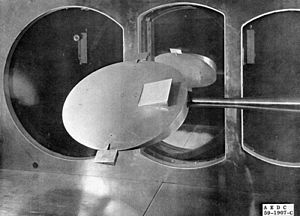Pye Wacket
| Pye Wacket | |
|---|---|
 Pye Wacket lenticular missile prototype with early exterior control surfaces | |
| Type | Air-to-air missile |
| Place of origin | United States |
| Production history | |
| Designer | Convair(General Dynamics) |
| Designed | 1957–1961 |
| No.built | Not produced |
| Specifications | |
| Mass | 510 lbs (230 kg) |
| Height | 9 inches (23 cm) |
| Diameter | 70 in (1.8 m) |
| Wingspan | 70 in (1.8 m) |
| Warhead | high explosive |
| Warhead weight | 55 lb (25 kg) |
| Engine | ThiokolM58A2solid-fuel rocketmotor x 3 10,200 lbf (4,600 kgf) thrust each |
| Propellant | solid rocket engine |
Operational range | 72 nm (133 km; 83 mi) |
| Flight ceiling | 77,350 ft (23,580 m) to sea level |
| Maximum speed | Mach 6.5+ |
Guidance system | Midcourse:autopilot Terminal:infrared homing |
Steering system | nitrogen-injected binarythrusters |
Launch platform | XB-70 Valkyrie(planned) |
Pye Wacketwas the codename for an experimentallenticular-formair-to-air missiledeveloped by theConvairDivision of theGeneral Dynamics Corporation[1]in 1957. Intended as a defensive missile for theB-70 ValkyrieMach 3 bomber, the program saw extensivewind-tunneltesting and seemed promising; however, the cancellation of the B-70 removed the requirement for the missile, and the project was cancelled.
Genesis
[edit]Project "Pye Wacket", officially known as theLenticular Defense Missile(LDM) Program and by the project numberWS-740A,[2]was instituted in 1958 in response to a US Air Force request for a Defensive Anti-Missile System (DAMS) to protect the proposedB-70 Valkyriestrategic bomberfrom high-speed, high-altitudesurface-to-air missiles(SAMs) andinterceptor aircraft.[3]
The extreme speed and operating altitude of the Valkyrie was considered sufficient protection against Soviet interceptors of the time.[4]However it was anticipated that future aircraft and missile developments would reduce the B-70's margin of superiority,[3]especially following theSA-2 GuidelineSAM being displayed during the 1957May Day parade.[5]Intelligence reports indicated that SAMs were being deployed in large numbers throughout Russia,[6]and it was believed the SA-2 was capable of being fitted with a nuclearwarhead.[7]Therefore, it was decided that the B-70 would need an interceptor missile to defend itself against the perceived threat.[3]
Design
[edit]
The specifications for the proposed DAMS called for an air-launched defensive missile, capable of engaging incoming missiles at relative speeds of up to Mach 7,[3]surviving a rate of acceleration between 60 g to 250 g, and being able to undertake rapid terminal-phase guidance changes in any direction.[8]
Following initial studies and wind-tunnel testing at theAir Proving Ground CenterandArnold Engineering Development Center,[3]a radically unconventional design emerged that featured a lenticular, wedge-shaped airframe.[3]The lenticular design was considered to have the best handling characteristics at extremely highangles of attack,and would theoretically possess ideal mass distribution, giving the missile outstanding terminal agility.[3]In addition, the lenticular design allowed for omnidirectional launching from the carrying aircraft.[2]
Following the feasibility studies, a contract for the development of the DAMS design was awarded to the Convair division of the General Dynamics Corporation inPomona, Californiain 1959.[3][9]Wind tunnel testing of several options for control of the missile resulted in an arrangement of six small rocket thrusters being selected for reaction control.[3]The airframe of the missile was constructed ofmagnesium alloy,and main power would be provided by threeThiokol M58A2 solid-fuel rockets.[3]
Cancellation
[edit]Pye Wacket was planned to be tested using arocket sled launcher,[3]with a Mach 5 booster rocket being used later in the test program.[2]There are unconfirmed reports that some tests were conducted in 1960.[3]However the high cost and perceived vulnerability of the B-70 against the projected performance of Soviet air defenses,[10]combined with the1960 U-2 incidentin which a high-flying spyplane had been shot down, led to the decision thatintercontinental ballistic missileswould, in the future, be the primary nuclear delivery force of the United States, and therefore the B-70 project was cancelled in early 1961.[11]Pye Wacket, its delivery vehicle no longer available, is believed to have been cancelled soon after,[3]although the ultimate fate of the program remains classified.[2]
See also
[edit]References
[edit]Notes
[edit]- ^Article title(a document from ARMED SERVICES TECHNICAL INFORMATION AGENCY)
- ^abcdUSAF 1961.
- ^abcdefghijklmParsch 2005
- ^Rees 1960, p.125.
- ^Hannah 2001, p.68.
- ^Crabtree 1994, p.107.
- ^Cochran et al. 1989, p.32.
- ^General Dynamics 1961.
- ^Article titleArchived2012-02-16 at theWayback MachinePye Wacket: Feasibility Test Vehicle Study. Summary. Volume 1. General Dynamics, July 1961.
- ^Greenwood 1995, p.289.
- ^Kennedy, John F."Remarks of Senator John F. Kennedy, Horton Plaza, San Diego, CA, November 2, 1960."The American Presidency Project atucsb.edu.Retrieved: 6 April 2009.
"1961 Budget Message."Kennedy ArchivesArchived2013-08-01 at theWayback Machine,28 March 1961, pp. I-38.
Bibliography
[edit]- Cochran, Thomas B.; William M. Arkin; Robert S. Norris; Jeffrey Sands (1989).Nuclear Weapons Databook, Volume IV: Soviet Nuclear Weapons.Pensacola, FL: Ballinger.ISBN978-0-88730-048-6.
- Crabtree, James D. (1994).On Air Defense.Westport, CT: Praeger.ISBN978-0-275-94792-7.
- General Dynamics; Convair/Pomona Division (July 1961).Pye Wacket. Feasibility Test Vehicle Study.Summary. Volume 1. Reproduced by Defense Technical Information Center. Retrieved on May 22, 2009.
- Greenwood, John T., ed. (1995).Milestones of Aviation: National Air and Space Museum.Westport, CT: Hugh Lauter Levin Associates.ISBN0-88363-661-1.
- Hannah, Craig C. (2001).Striving for air superiority: the Tactical Air Command in Vietnam.College Station, TX: TAMU Press.ISBN978-1-58544-146-4.Retrieved2010-12-02.
- Rees, Ed (October 17, 1960)."The Furor Over Fantastic Plane".Life.Vol. 49, no. 16. TIME Inc.Retrieved2010-12-02.
- Parsch, Andreas (2005)."Convair Pye Wacket".Directory of U.S. Military Rockets and Missiles, Appendix 4: Undesignated Vehicles.designation-systems.net.Retrieved2010-12-02.
- US Air Force (1961)History of the Arnold Engineering Development Center: July - December 1960.II-24, IL-25. Reproduced per request to Air Force Historical Research Agency. Retrieved on May 22, 2009.
